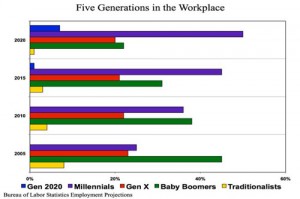The workforce is entering a unique period between 2015 and 2020 when fully five generations will be in the labor pool at the same time. Organizational development experts have given much attention to the interpersonal challenges of this circumstance. You can hire any number of experts who will train you how to work to successfully integrate the styles of multiple generations in the workforce. Let me suggest that tensions extend beyond the social implications of this phenomenon.
This particular demographic distribution as shown in the Bureau of Labor Statistics chart below demonstrates a convergence of talents, skills, and attributes that need to be conveyed not from one generation to the next but perhaps from one generation to another that is three degrees removed from it. That transfer presents several challenges including both what and how that learning is relayed. It is also happening in a time of technological advances that alter assumptions about what is important.
Generational filters require that knowledge, skills and attitudes (KSA’s in training parlance) not only be captured, but also preserved and translated in such a way that the knowledge itself remains relevant and usable to a workforce with different frames of reference.
In this context, organizations face the challenge of finding their experts and preserving their knowledge in ways that make it accessible to their grandchildren and great-grandchildren.
Start by reflecting on the context of the kind of labor that is leaving your organization. Each business must examine the kinds of KSA’s that built your successful organization so that you can accurately identify what to capture and how to capture it. Then organizations need to create a system for identifying and transferring the critical knowledge and talent that is leaving the workforce in unprecedented numbers.
When people leave, the worst thing that can happen is that they take critical skills sets with them that you cannot replace. The second worst thing that can happen is that, when you discover they possessed irreplaceable pieces of your corporate puzzle, you hire them back as consultants at exorbitant rates on their own time schedule. And the best outcome is that you use their last, best years with your company capturing what they know. If you are shooting for the best outcome, make sure you have a process in place today to preserve your organization’s competitive advantages.


Please note: I reserve the right to delete comments that are offensive or off-topic.